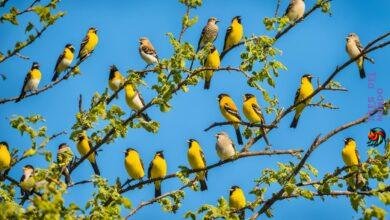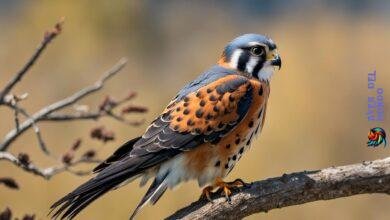Did you know that providing birdhouses in your backyard can help attract a wide variety of bird species, ranging from bluebirds and swallows to chickadees and woodpeckers?
Creating a cozy haven for these feathered friends is easier than you think. With our step-by-step birdhouse tutorial, even woodworking beginners can successfully build their own birdhouses. Whether you’re seeking birdhouse design ideas, looking for easy birdhouse construction tips, or searching for DIY bird feeder plans, we’ve got you covered.
In this article, we’ll guide you through the process of building your own birdhouse, from selecting the materials and equipment to hanging or mounting the finished product. You’ll discover how simple it is to create a welcoming habitat for birds while indulging your creative side.
So, roll up your sleeves and get ready to embark on a rewarding DIY birdhouse project that will bring joy to both you and your feathered friends.
Materials and Equipment Needed to Build Birdhouse
When it comes to building your own birdhouse, having the right materials and tools is essential. Here’s a list of what you’ll need:
- Wood Board: You’ll need a 1″ x 6″ x 5′ wood board. Opt for a durable and weather-resistant wood like cedar or pine, which are commonly used for birdhouse construction.
- Screws: Approximately 1.5″ screws will be necessary to securely assemble the birdhouse. Make sure the screws are suitable for outdoor use.
- Power Drill: A power drill will be your go-to tool for creating holes and fastening screws. It will make the process much quicker and easier.
- Hand Saw: You’ll need a hand saw to cut the wood board according to the birdhouse plan dimensions. Ensure it’s sharp and suitable for precise woodworking.
- Drill Bit: To create the entrance hole for the birds, use a drill bit that matches the desired hole size. The specific size will depend on the bird species you want to attract.
Gather the Right Materials
Before starting, make sure you have all the necessary materials and equipment at hand. This will ensure a smooth and efficient building process.
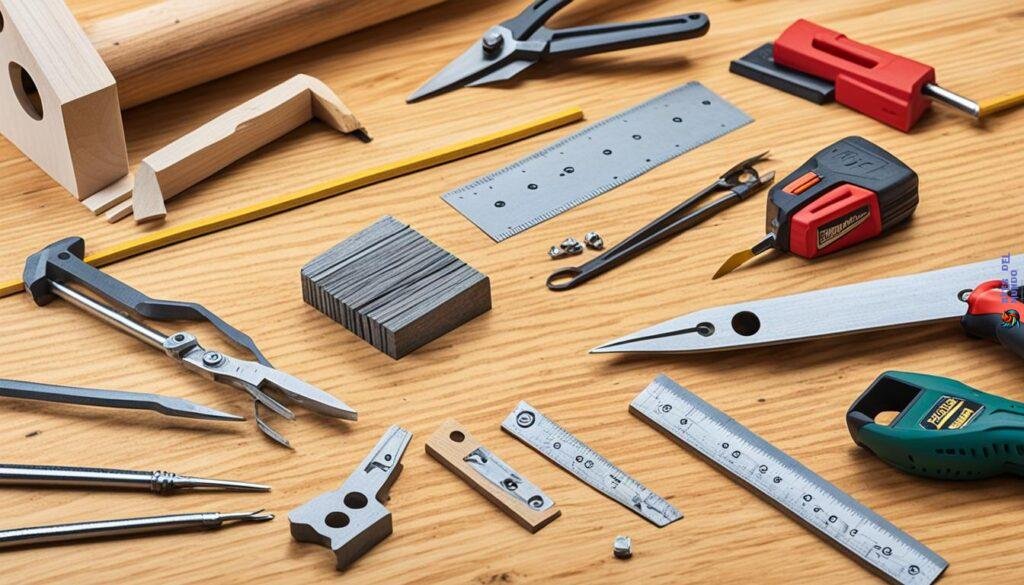
| Materials | Tools |
|---|---|
| 1″ x 6″ x 5′ wood board | Power drill |
| Approximately 1.5″ screws | Hand saw |
| Drill bit (matching desired entrance hole size) |
Cutting and Preparing the Board
Follow these steps to cut and prepare the wood board for the birdhouse:
- Cut the 1×6 board according to the measurements provided in the birdhouse plans.
- Optionally, sand all the pieces smooth for a polished finish.
- Use a drill bit to create the entrance hole for the birdhouse. The plans specify a 1.5″ hole, positioned 4″ off the floor.
- Pre-drill the necessary holes to prevent the wood from splitting during assembly.
If you want to attract bluebirds, tree swallows, chickadees, nuthatches, warblers, woodpeckers, and wrens, make sure to follow the cutting and drilling instructions.
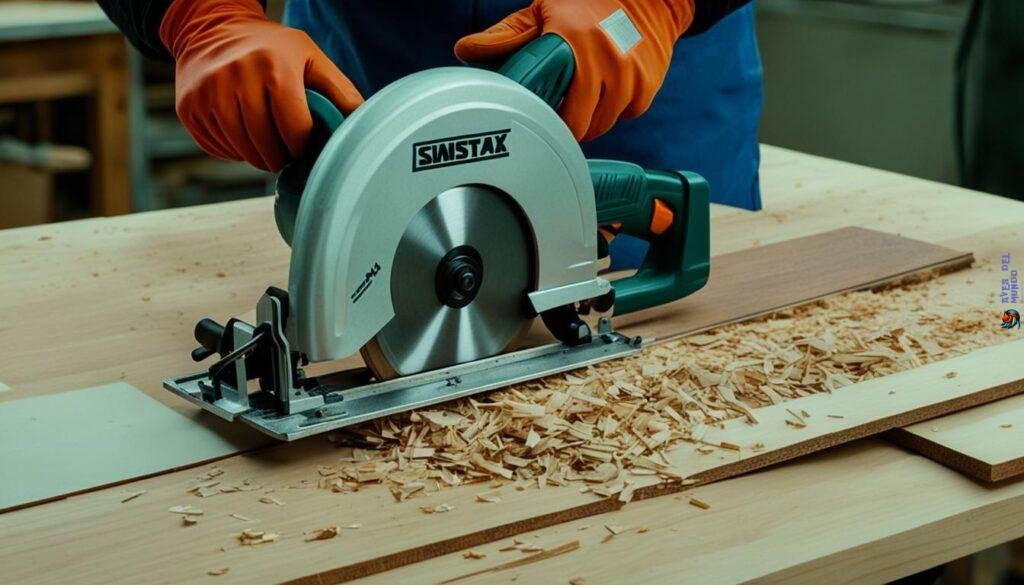
Key Steps:
- Cut the 1×6 board to size
- Sand the pieces for a smooth finish
- Drill the entrance hole
- Pre-drill holes to prevent splitting
Sanding Tips:
If you choose to sand the birdhouse pieces for a polished finish:
- Use medium-grit sandpaper to remove any rough edges or splinters.
- Sand in the direction of the wood grain for a consistent and smooth result.
- Once the rough edges are smoothed out, switch to fine-grit sandpaper for a finer finish.
- Wipe away any dust or debris before proceeding with the next steps.
Pro Tip: Sanding the birdhouse pieces not only creates a visually appealing result but also prevents any potential injuries to birds caused by rough surfaces.
Cutting the Front and Drilling the Entrance Hole:
When cutting the front of the birdhouse, make sure to follow the specifications provided in the plans. This will ensure the proper size and alignment of the entrance hole.
Using a drill and a suitable drill bit, carefully create the entrance hole according to the specified dimensions. Position the hole 4″ off the floor to attract your desired bird species.
| Wood Cutting Instructions | Entrance Hole Drilling Instructions |
|---|---|
| Cut the 1×6 board to the required lengths for the birdhouse pieces. | Use a drill and a 1.5″ drill bit to create the entrance hole 4″ off the floor. |
| Sand all the cut pieces smooth for a polished finish. | Pre-drill the necessary holes to prevent splitting during assembly. |
Following these cutting and drilling steps will ensure precise and professional results for your DIY birdhouse project.
Assembling the Sides and Floor
Now that you have prepared the wood pieces, it’s time to assemble the sides and floor of your birdhouse. This step is crucial for creating a sturdy and functional structure that will attract birds to your garden.
To begin, gather your materials and make sure you have a waterproof wood glue and the appropriate screws on hand. Using glue in combination with screws will ensure a secure and long-lasting birdhouse.
Here’s a step-by-step guide to assembling the sides and floor of your birdhouse:
- Apply a generous amount of waterproof wood glue to the edges of the back piece.
- Position the back piece on the bottom piece (floor) of the birdhouse, aligning the edges.
- Secure the back piece to the floor by driving screws through the back and into the floor. Be careful not to over-tighten the screws, as it may cause the wood to split.
- Repeat the process with the side pieces, applying glue to the edges and securing them to the floor and back using screws.
- Finally, attach the front piece to complete the assembly. Apply glue to the edges and use screws to secure it to the sides and floor.
For a more polished look, consider using trim screws to minimize the visibility of the screws and give your birdhouse a professional finish.
If you would like to provide a landing spot for birds, add a perch to the birdhouse. You can attach a small branch or dowel to the front piece using glue and screws. This will give the birds a place to rest and observe their surroundings.
With the sides and floor successfully assembled, your birdhouse is starting to take shape. In the next section, we will guide you through building the roof to complete your DIY birdhouse project.
Building the Roof
Now it’s time to assemble the roof for your DIY birdhouse. The roof not only adds charm to the design but also provides essential protection against the elements. Follow these steps to ensure a sturdy and functional roof:
- Attach the two roof panels together to form the roof structure. Make sure to align them properly and secure them with screws. This will create a solid foundation for the roof.
- Adjust the width of one of the top panels if necessary to achieve a consistent overhang on both sides. This will ensure a symmetrical and aesthetically pleasing look.
- Use screws to secure the assembled roof onto the birdhouse. Make sure to position the screws in a way that allows easy access for cleaning and maintenance in the future.
- Consider adding a clean-out door to the birdhouse for convenient cleaning. This feature allows easy removal of old nesting materials, promoting a healthy and inviting environment for the birds.
- Drill several drainage holes in the floor of the birdhouse to prevent water accumulation. This will help keep the nest area dry and prevent potential damage.
Remember, a well-built and properly assembled roof is crucial for the longevity and functionality of your birdhouse. Take your time during this step to ensure a secure and durable roof structure.
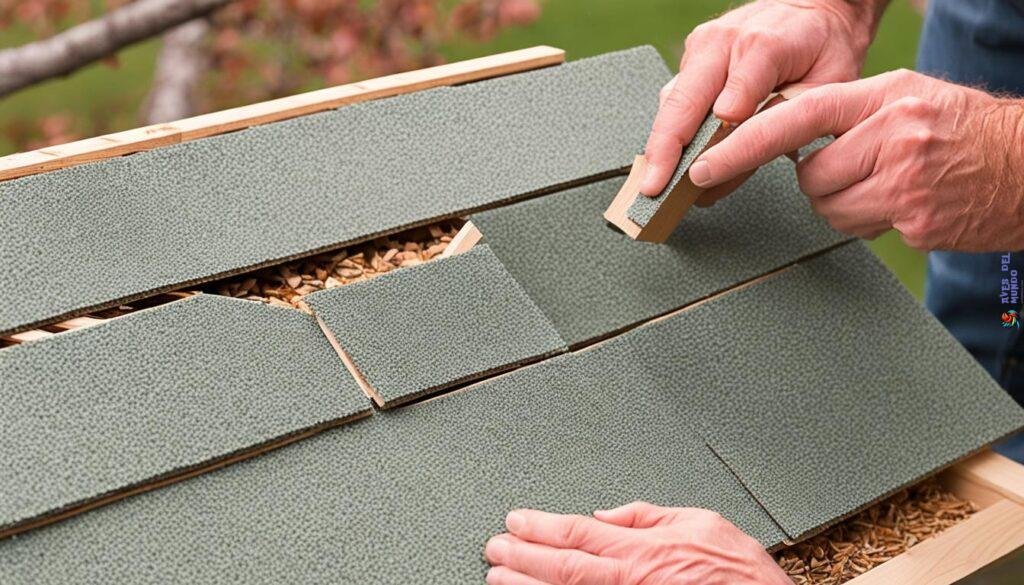
Continue reading to learn about the next step: Section 6: Painting or Finishing the Birdhouse.
Painting or Finishing the Birdhouse
Now that you have successfully built your DIY birdhouse, it’s time to add the finishing touches. Painting or finishing the birdhouse not only helps protect it from the outdoor elements but also gives you the opportunity to customize its appearance. One popular option for finishing birdhouses is to use linseed oil, which not only enhances the natural beauty of the wood but also provides excellent protection against damage.
Linseed oil is a natural, eco-friendly choice for preserving wood. When applied to the birdhouse, it penetrates the wood fibers, making them more resilient to weathering and rot. It also helps bring out the wood’s grain, giving it a warm and inviting look.
To apply linseed oil to your birdhouse, simply brush it onto the surface of the wood, making sure to cover all sides and edges. Allow the oil to soak in for a few minutes, then wipe off any excess with a clean cloth. For optimal protection, you may want to apply multiple coats, allowing each coat to dry thoroughly before adding the next.
If you prefer a more colorful birdhouse, you can also use exterior paint or stain to achieve the desired look. Just make sure to choose a non-toxic paint or stain that is safe for birds.
Experiment with different finishes and colors to create a birdhouse that matches your outdoor decor and personal style. Whether you opt for the natural beauty of linseed oil or the vibrant hues of paint, the final result will be a stunning addition to your backyard or garden.

Hanging or Mounting the Birdhouse
Now that your birdhouse is complete, it’s time to find the perfect spot to hang or mount it. The location you choose plays a crucial role in attracting birds and ensuring their safety. Follow these tips for successful birdhouse installation:
Recommended Mounting Height for Birds
Different bird species have varying preferences when it comes to the height at which they nest. To increase the chances of birds inhabiting your birdhouse, it’s essential to know the recommended mounting height for your target species. Here are some general guidelines:
- Bluebirds: Mount the birdhouse on a pole or post approximately 4 to 6 feet off the ground.
- Swallows: Hang the birdhouse from the eaves of a building or fasten it on a post about 10 to 15 feet high.
- Chickadees: Place the birdhouse 6 to 15 feet high in a shaded area.
- Nuthatches: Mount the birdhouse on a tree trunk or post about 6 to 10 feet high.
- Warblers: Hang the birdhouse from a tree branch 6 to 15 feet high.
- Woodpeckers: Attach the birdhouse to a tree trunk 12 to 20 feet high.
- Wrens: Hang the birdhouse from the side of a building or a tree branch about 6 to 10 feet high.
Remember to consider the surroundings when selecting the ideal spot for your birdhouse. Birds prefer locations with nearby perching spots, such as trees or shrubs, where they can rest and observe their surroundings. Providing a safe and inviting environment for birds increases the likelihood of them choosing your birdhouse as their new home.
For a visual reference, here’s an image of a birdhouse mounted at the recommended height, attracting beautiful birds to its cozy shelter:
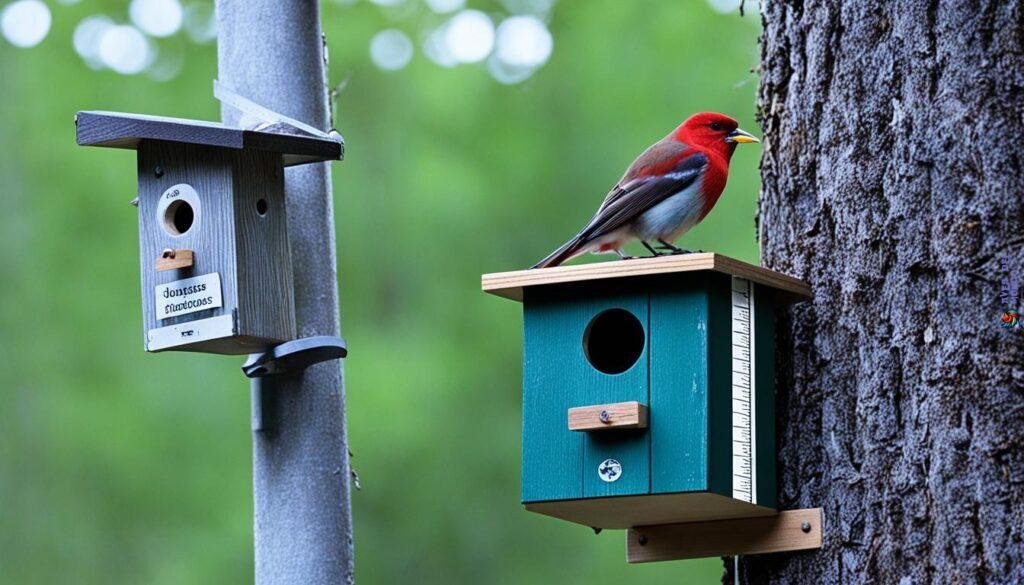
By following these birdhouse installation tips, you’ll create an appealing space for feathered friends to call home. Enjoy the sights and sounds of nature as you bring life to your outdoor space with these DIY birdhouse plans.
DIY Birdhouse Experience as a Family Project
Building a birdhouse can be a fun and educational project that brings the family together and creates lasting memories. By involving everyone in the process, you not only strengthen the bond between family members but also foster a sense of responsibility towards nature.
Constructing a birdhouse as a family project provides an opportunity to teach children about the importance of wildlife conservation and the role birds play in maintaining a healthy ecosystem. Kids can learn about different bird species, their nesting habits, and the benefits of creating a suitable habitat for them in your backyard.
Encouraging birds to make their homes in your birdhouse is not only rewarding but also offers several advantages for both your family and garden. Birds are natural pest controllers, feeding on insects and pests that may damage your plants. By attracting birds to your garden with a birdhouse, you can enjoy the benefits of natural pest control without the need for harmful chemicals or pesticides.
Additionally, welcoming neighborhood birds to your backyard contributes to the overall ecological balance by supporting local bird populations. It provides them with a safe haven to raise their young, ensuring their survival and promoting biodiversity in your area.
So, gather your family and embark on a DIY birdhouse project that not only brings joy and togetherness but also contributes to the well-being of your garden and the local bird community.

| Benefits of Building a Birdhouse as a Family Project |
|---|
| 1. Promotes family bonding and teamwork |
| 2. Provides an educational experience for children |
| 3. Teaches responsibility and respect for nature |
| 4. Encourages natural pest control in the garden |
| 5. Supports local bird populations and biodiversity |
Birdhouse Design Ideas and Inspiration
If you’re looking to add more charm and diversity to your garden, exploring different birdhouse designs can be a great way to attract a variety of bird species. With countless free plans available online, you have access to a wealth of inspiration to create the perfect bird-friendly haven. These designs not only cater to different bird species but also include options for bird feeders, expanding the scope of your bird-watching experience.
1. Classic Birdhouse
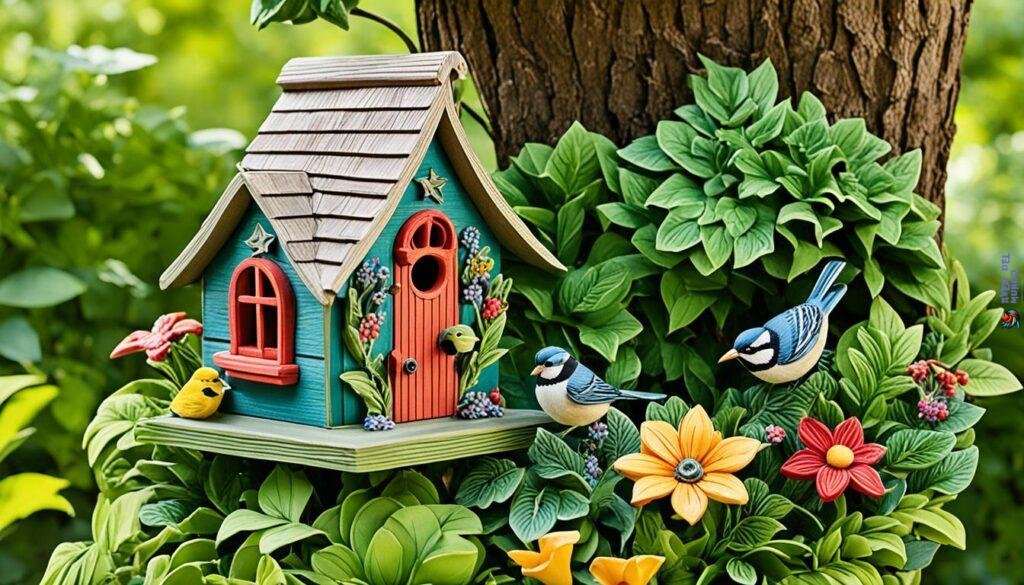
For a timeless and traditional look, consider building a classic birdhouse. With its simple yet elegant design, this style appeals to a wide range of bird species. It typically features a square or rectangular shape, an entrance hole, and a sloping roof to protect the birds from the elements.
2. Rustic Cottage Birdhouse
If you prefer a more whimsical look, a rustic cottage birdhouse might be the perfect choice. This design adds a touch of charm to your garden with its quaint cottage appearance, complete with textured walls, a sloping roof, and decorative elements. It creates a cozy and inviting atmosphere for birds to make their homes.
3. Tree Trunk Birdhouse
Embrace nature by building a birdhouse that mimics a tree trunk. This design seamlessly blends into the natural surroundings, offering birds a sense of security and camouflage. It typically features a cylindrical shape with textured bark details and an entrance hole that resembles a natural cavity.
«Building a birdhouse doesn’t just provide shelter for birds; it also adds a beautiful focal point to your garden and allows you to observe the wonders of nature up close.» – Crafty Birdhouse Builders
4. Multi-Level Birdhouse
Take your birdhouse to new heights with a multi-level design. This unique style features multiple levels or compartments, providing ample space for different bird species to nest. Each level can be accessed through separate entrances, fostering a vibrant bird community in your garden.
5. Themed Birdhouses
Inject a dash of creativity and personalization into your birdhouse designs by choosing a theme. Whether it’s a beach hut, a log cabin, or a lighthouse, themed birdhouses add character and whimsy to your outdoor space. Consider incorporating elements like miniature furniture, signs, or landscaping to further enhance the theme.
6. Recycled Birdhouses
Opt for an eco-friendly approach by repurposing household items into unique birdhouses. Not only will you reduce waste, but you’ll also add a touch of innovation to your garden. Turn teapots, old boots, or vintage tins into charming birdhouses that provide both style and shelter for your feathered friends.
Remember, each bird species has specific habitat preferences and nesting requirements, so it’s essential to research their needs when choosing a birdhouse design. By selecting an appropriate design and considering the placement and mounting height, you can create an inviting environment that attracts a diverse array of bird species to your garden.
Additional DIY Birdhouse Projects
In addition to building birdhouses, there are numerous other bird-related DIY projects that you can undertake to create a bird-friendly environment in your garden. These projects not only attract a wider variety of birds but also add visual appeal to your outdoor space. Consider incorporating the following projects into your DIY endeavors:
1. Trellis
A trellis provides a vertical structure for climbing plants and vines, giving birds the opportunity to perch and nest. Construct a sturdy trellis using wood or metal, ensuring it is securely anchored in the ground. Plant flowering vines such as honeysuckle or clematis to attract birds with their colorful blooms and sweet fragrances.
2. Obelisk
An obelisk is another vertical structure that can double as a decorative element in your garden. Crafted from wood or metal, an obelisk serves as a focal point and can host hanging bird feeders or nesting boxes. Choose a design that matches your garden’s aesthetic and watch as birds utilize this elevated space.
3. Lanterns
Add charm and illumination to your garden by creating DIY lanterns that can attract birds during the evening hours. Use weather-resistant materials such as metal, glass, or ceramic to craft lanterns of varying sizes and shapes. You can even incorporate small bird-friendly elements, such as perches or shallow water dishes, into the lantern design.
4. Hanging Baskets
Hanging baskets not only beautify your garden but also provide nesting opportunities for birds. Choose baskets made of natural materials like wicker or moss, and fill them with bird-friendly plants such as petunias, fuchsias, or lobelia. Hang the baskets in strategic locations to attract bird visitors and provide them with comfortable places to raise their young.
5. Window Boxes
Enhance your windows with bird-friendly window boxes, which allow you to bring nature up close. Construct the boxes with durable materials such as wood or PVC and add a variety of plants that attract birds, such as sunflowers, marigolds, or zinnias. Enjoy the sight of birds perching outside your windows, adding beauty and joy to your everyday life.
| Project | Materials Needed |
|---|---|
| Trellis | Wood or metal, anchoring materials, flowering vines |
| Obelisk | Wood or metal, decorative elements, hanging feeders/nesting boxes |
| Lanterns | Metal, glass, or ceramic, weather-resistant materials, optional perches or water dishes |
| Hanging Baskets | Natural materials (wicker or moss), bird-friendly plants |
| Window Boxes | Wood or PVC, bird-friendly plants |
These additional DIY birdhouse projects offer endless opportunities for creativity and customization. Implementing them in your garden not only provides birds with shelter and nesting options but also enhances the beauty and ecosystem of your outdoor space.
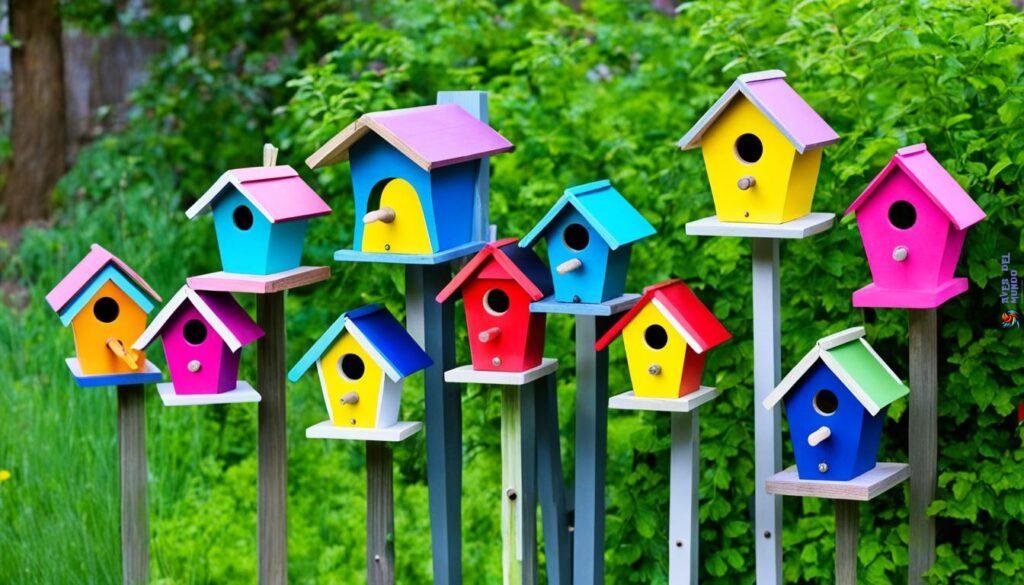
Importance of Providing Habitat for Birds
Creating a safe and welcoming habitat for birds in your garden is not only aesthetically pleasing but also essential for preserving bird populations. By offering shelter, food, and water, you can encourage these beautiful creatures to nest and thrive in your outdoor space, contributing to the overall preservation of bird populations and biodiversity.
Attracting birds to your garden is a rewarding experience that allows you to observe their behavior and enjoy their lovely songs. However, it goes beyond mere observation. By providing a safe habitat, you are actively participating in the preservation of bird populations and the ecological balance of your ecosystem.
Promoting Nesting and Reproduction
When you create a bird-friendly environment with suitable birdhouses, feeding stations, and water sources, you are providing birds with the resources they need to build nests and raise their young. This helps ensure successful breeding and the continuation of bird populations.
Controlling Pest Populations
Attracting birds to your garden also offers the benefit of natural pest control. Many bird species, such as swallows and chickadees, feed on insects, helping to reduce populations of pests that can damage your plants and crops. By creating a habitat that welcomes birds, you are inviting nature’s pest controllers into your garden, reducing the need for harmful chemical pesticides.
Contributing to Biodiversity
Birds play a crucial role in maintaining biodiversity. They help with the pollination of plants and the dispersal of seeds, promoting the growth of a variety of plant species. In turn, this supports other forms of wildlife, such as insects and small mammals, creating a thriving and balanced ecosystem.
By providing a habitat for birds in your garden, you are not only creating a beautiful and tranquil space but also actively contributing to the preservation of bird populations and the natural balance of your environment.

Image: A bird perched on a tree branch, symbolizing the benefit of attracting birds to your garden.
Related DIY Projects and Inspiration
If you’re interested in more than just DIY birdhouses, there are plenty of exciting projects you can explore to enhance your living space. Whether you need additional storage, want to add a stylish accent to your walls, or create a cozy focal point in a room, these DIY projects offer endless inspiration.
Building storage space is a practical project that can help you declutter and organize your home. From custom shelving units to cleverly designed cabinets, there are numerous possibilities to maximize your storage potential.
To add a touch of style and personality to your walls, consider creating a trim accent wall. By using decorative trim pieces, you can achieve a unique and eye-catching look that transforms any room into a showpiece.
If you’ve always wanted to cozy up your living space, constructing a faux fireplace mantel surround can be an excellent DIY project. This charming addition can bring warmth and charm to your room, even without the need for an actual fireplace.
For coffee lovers, a farmhouse coffee cup stand is a must-have accessory. With its rustic charm and practical design, this DIY project allows you to display your favorite mugs in a stylish way, adding a touch of farmhouse-inspired decor to your kitchen or dining area.
Creating an outdoor bench is the perfect project for enjoying nature and enhancing your outdoor living space. With a few simple materials and tools, you can build a comfortable seating area where you can relax and soak up the sunshine.
If you’re in need of a functional workspace, designing a corner desk can be a game-changer. Whether for work or study, this DIY project provides a versatile and space-saving solution for setting up an efficient and stylish workstation.
With these related DIY projects, you can unleash your creativity and personalize your living space. Whether you’re looking for practical storage solutions, stylish accents, or functional furniture pieces, these projects will inspire you to embark on new DIY adventures.


